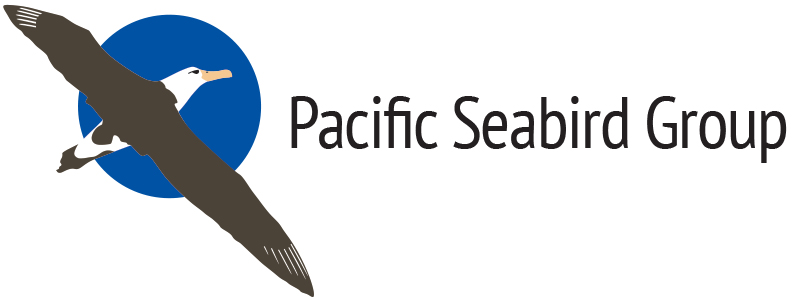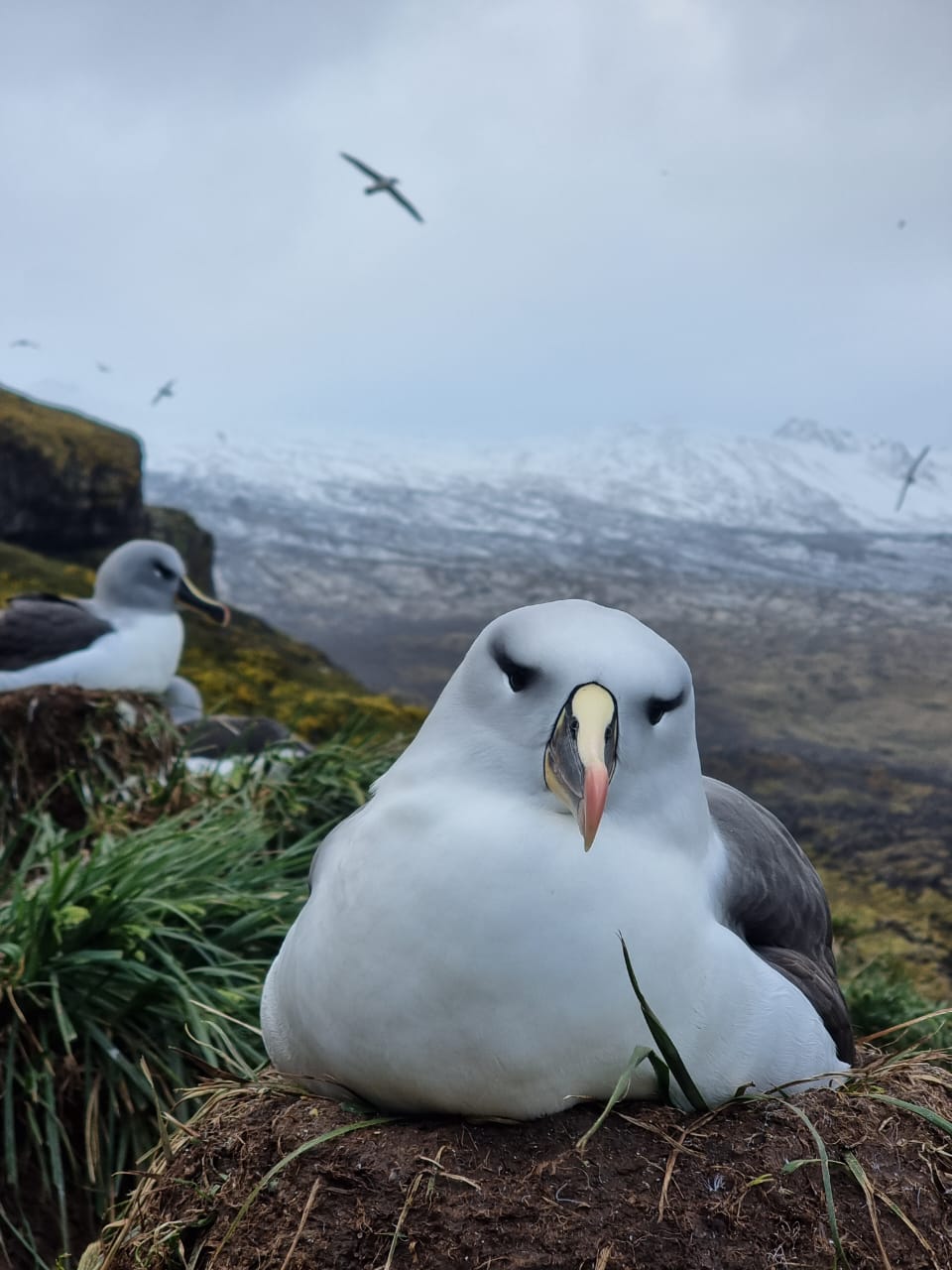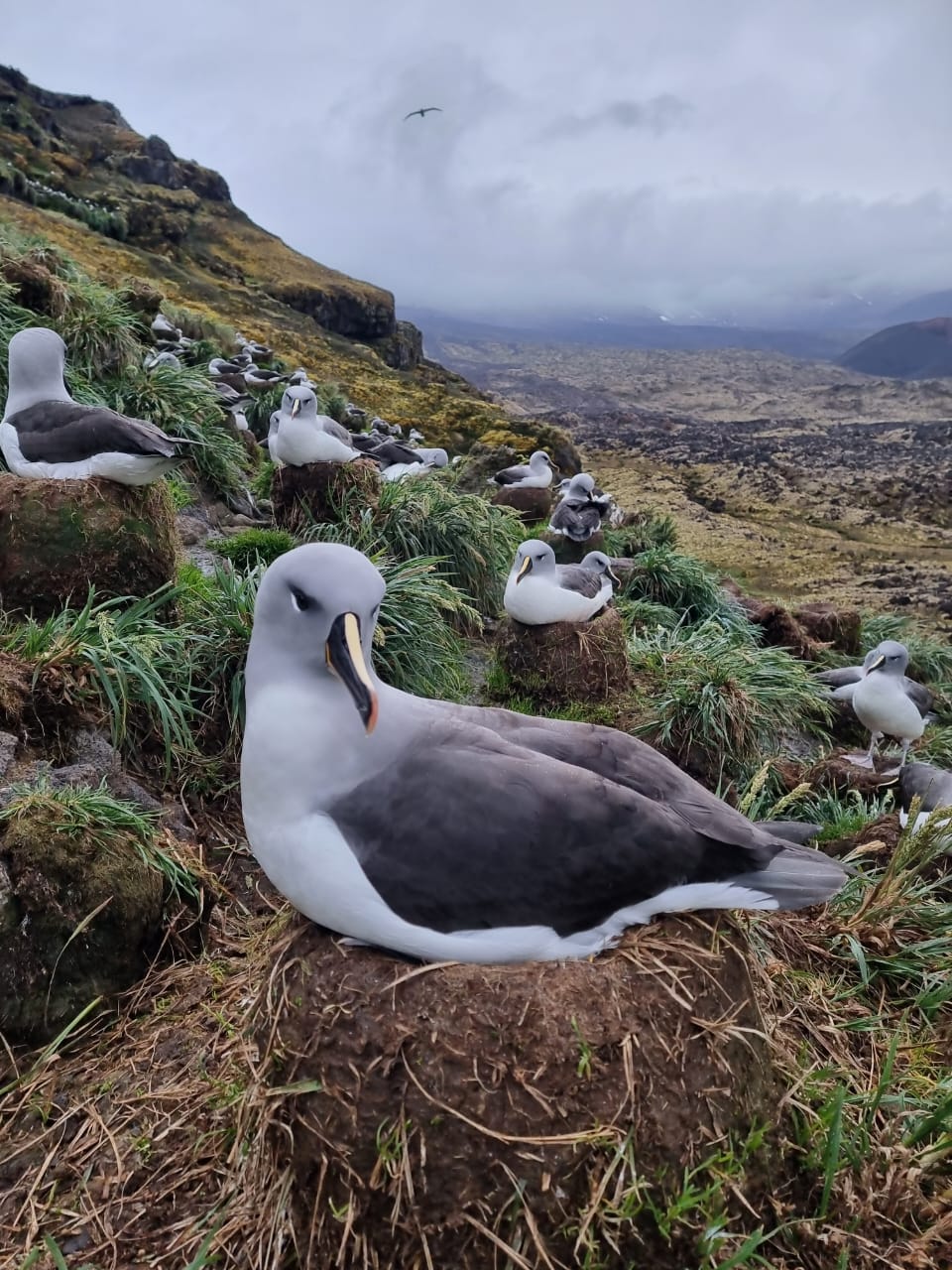 Balearic Shearwater, mixed media by Catarina Vitorino, Artists and Biologists Unite for Nature, after a photograph by Pep Arcos
Balearic Shearwater, mixed media by Catarina Vitorino, Artists and Biologists Unite for Nature, after a photograph by Pep Arcos
The Critically Endangered Balearic Shearwater Puffinus mauretanicus of the Mediterranean Sea is the second-last species (and the first shearwater) to be added to ACAP’s Annex 1, following a decision taken at the Fourth Session of the Meeting of the Parties (MoP4) held in Lima, Peru in April 2012.
Endemic to Spain’s Balearic Islands, the species has an interesting taxonomic history. It was described in 1921 by the English ornithologist Percy Lowe, who treated it as a subspecies Puffinus puffinus mauretanicus of the Manx Shearwater. A later categorization placed it as a subspecies of the then-named Mediterranean Shearwater P. yelkouan (itself once considered a subspecies of the Manx Shearwater). It was then considered to be a full species, with the now-named Yelkouan Shearwater as a separate species. However, the presence of seemingly hybrid birds raised questions on the taxonomic categorisation of the Balearic and Yelkouan Shearwaters as full species.
As a full species the Balearic Shearwater was awarded the conservation status of Lower Risk/Near Threatened in 2000, and then as Critically Endangered in 2004, a category of threat it has kept through a number of reviews to the current day (click here). Its categorizaton also added to the impetus that led Spain to successfully propose the species be added to the Agreement’s Annex 1 (click here).
A molecular study published in 2021 found very little genetic difference between the Balearic and Yelkouan Shearwaters, leading to the authors of the study to suggest that the two taxa might be better considered as conspecific (click here), proposing that the Balearic Shearwater should be considered as a subspecies of the Yelkouan as P. y. mauretanicus. Not surprisingly, this opinion led the ACAP Taxonomy Working Group (TWG) to consider the matter and its implication for the Albatross and Petrel Agreement. The TWG, follow its online discussions, included the matter it its report to the 13th Meeting of the ACAP Advisory Committee (AC13), held in Edinburgh, Scotland in May 2023. The TWG wrote: “Obiol et al. (2023) conducted a comprehensive genetic analysis of the Puffinus shearwaters of the North Atlantic and Mediterranean. They found that current taxonomies are not supported by genomic data and propose a more accurate taxonomy by integrating genomic information with other sources of evidence. With particular relevance to ACAP, they found no support for the split of Balearic Shearwater (Puffinus mauretanicus) and Yelkouan Shearwater (P. yelkouan) into two different species and propose that these two Mediterranean taxa should be considered as conspecific. Taxonomic precedence would then make the Balearic Shearwater a sub-species (or sub-population) of Yelkouan Shearwater. If this analysis is accepted, this presents a difficulty for ACAP as Article 1.1 states “This Agreement shall apply to the species of albatrosses and petrels listed in Annex 1 to this Agreement”, in other words Annex 1 should list species, not separate sub-species or populations. Guidance on this issue is requested from the Advisory Committee.”
AC13 then discussed the status of the Balearic Shearwater, noting in its report that advice from Australia that species, subspecies or populations could be listed in Annex 1 of the Agreement. “Article I (1) of the Agreement was to be read together with Article I (2)(a) that further defines the terms ‘albatross’ and ‘petrel’. Read together, the terms ‘albatross’ and ‘petrel’ in Article I (1) of the Agreement could refer to a species, subspecies or population of the albatross or petrel.” This was relevant to possible future approaches to the listing in Annex 1 to the Agreement of the Balearic Shearwater. The Advisory Committee then agreed in its meeting report to await the outcome of deliberations by the taxonomic committee of the International Ornithological Congress (IOC), before considering further any consequences for Annex 1 of the Agreement.
The authors of the 2022 taxonomic review state that the two taxa “are good examples of differentiated populations worthy of consideration as intraspecific units that represent unique morphological, ecological and genetic diversity for conservation of biodiversity. We stress that developing action plans for P. mauretanicus and P. yelkouan should not depend on whether these taxa are classified as separate species or not.” With this in mind, it seems sensible that the Balearic Shearwater remains listed by the Agreement on Annex 1, changing its scientific designation to P. yelkouan mauretanicus, if that becomes the view of the IOC.

Yelkouan Shearwaters in flight, photograph by Pep Arcos
It is also thought worthwhile to consider the situation of the Yelkouan Shearwater in relation to ACAP. Its current category of threat is Vulnerable. If it is reclassified as including the Critically Endangered Balearic Shearwater (sensu stricto), this might conceivably result in it being considered Endangered, and thus potentially of greater interest to ACAP. In an ACAP Monthly Missive written a year ago I considered whether the Yelkouan Shearwater should be listed on ACAP’s Annex 1, writing that such a listing “would add up to nine more countries as breeding range states to those non-Party breeding range states (Japan, Mexico and the United States) with which ACAP already interacts, with the obvious issue of potentially over-extending the capacity of a small Secretariat. Inviting even Greece, Italy and Malta, the most important non-Party breeding states, to ACAP meetings would also have financial and person power consequences.” I concluded that ACAP should keep a “watching brief” on international efforts to improve the Yelkouan Shearwater’s conservation status. It has been quite some time since ACAP added a new species to its Annex 1 (the Vulnerable Pink-footed Shearwater Ardenna creatopus in 2015 being the last (click here). I shall follow with interest how ACAP treats any changes to its listing of threatened shearwaters in future years.
Reference
Obiol, J.F., Herranz, J.M., Paris, J.R., Whiting, J.R., Rozas, J., Riutort, M. & González-Solís, J. 2022. Species delimitation using genomic data to resolve taxonomic uncertainties in a speciation continuum of pelagic seabirds. Molecular Phylogenetics and Evolution 179. doi.org/10.1016/j.ympev.2022.107671.
John Cooper, Emeritus Information Officer, Agreement on the Conservation of Albatrosses and Petrels, 12 December 2023
NOTE: There will be a break in posting ACAP Monthly Missives in the New Year. I hope to restart the series if suitable subjects come to mind, or guest missives are offered.


 English
English  Français
Français  Español
Español 




 Balearic Shearwater, mixed media by Catarina Vitorino, Artists and Biologists Unite for Nature, after a photograph by Pep Arcos
Balearic Shearwater, mixed media by Catarina Vitorino, Artists and Biologists Unite for Nature, after a photograph by Pep Arcos
 From the paper: Fig 2. The relationship between wing loading (N m−2) and aspect ratio (dimensionless) for flying birds
From the paper: Fig 2. The relationship between wing loading (N m−2) and aspect ratio (dimensionless) for flying birds